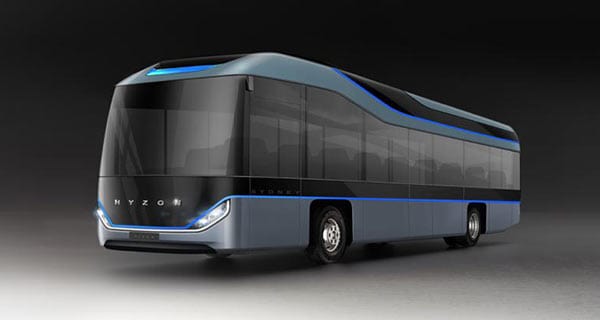Investing
JPMorgan Sees Big Gains for Alt Mobility Stocks Hyzon, Blade, Westport

Published:
Last Updated:

A new report released Thursday morning by Columbia University’s Center on Global Energy Policy makes clear what has been happening with oil over the past five decades: “Oil has become a lot less important and humanity has become more efficient in making use of it.”
In 1973, it took almost a full 42-gallon barrel of oil to generate $1,000 (adjusted to 2015 levels) in global GDP, a metric known as oil intensity. By 2019, oil intensity had fallen by 56% and the same inflation-adjusted $1,000 required just 18 gallons of oil. Oil intensity has been on a steady decline since 1984 “in an almost perfectly linear fashion.”
[in-text-ad]
The authors cite two principal reasons for the decline:
First, global oil intensity has declined as a larger share of global GDP has moved from industry into services. Second, the scope for interfuel substitution baked into the capital stock diminishes as the capital stock responds to the demands of higher income levels.
Automakers are among the industries baking less polluting fossil-fuel substitutes into their products. Electric vehicles are one substitute, but there are others, including hydrogen.
The result is a developing industry in what often is called alternative (or alt) mobility. JPMorgan analyst Bill Peterson on Thursday initiated coverage on three stocks of companies developing alt mobility products.
Hyzon Motors Inc. (NASDAQ: HYZN) is a pure-play hydrogen fuel-cell company. Peterson initiated coverage with an Overweight rating and a price target of $18 at the end of 2022. The company came public in mid-July after being spun out of Singapore’s Horizon Fuel Cell Technologies, a firm with a 20-year history designing and making fuel cells. At the time of the merger, Hyzon was valued at around $2.7 billion, including a capital raise of around $626 million.
According to Peterson, Hyzon’s first targets are the “hard-to-decarbonize commercial and heavy-duty transportation sectors, starting first with hydrogen fuel cell-based heavy-duty trucking and buses with plans to expand to rail, marine, and aviation in the future.” Peterson expects the company “to be a leader in emerging fuel cell-based mobility applications.”
Hyzon’s stock traded below its first-day closing price of $7.70 for most of the next four weeks. Since then, the stock is up nearly 32% even after dropping more than 15% in the first two trading days of this week. The stock traded up about 17% on Thursday morning, at $10.29 in a 52-week range of $6.02 to $19.95. At Peterson’s price target, the upside potential on Hyzon stock is nearly 80%.
Peterson also initiated coverage on Blade Air Mobility Inc. (NASDAQ: BLDE) with a rating of Overweight and a price target for the end of 2022 of $16. Blade is a first mover in what he calls the urban air mobility category. As such, Blade “has strong growth momentum that should accelerate on rising brand awareness and with increased use of the innovative on-demand and scheduled flight services, [and] expansion into new routes ….”
Where Blade really gets interesting is in its recent commitment to introducing electric vertical takeoff and landing aircraft (eVTOLs) by the middle of this decade. In an earlier note, Peterson and his colleagues said that eVTOL aircraft “can change the way people travel.” Peterson also notes that by some estimates, the total available market for eVTOL transportation may reach $1 trillion in the next five to 10 years.
Another believer in Blade is ARK Invest’s Cathie Wood. The firm’s Autonomous Technology & Robotics and Space Exploration and Innovation ETFs combined own about 5.93 million shares of Blade, as of Wednesday’s close. That’s 2 million more than the ARK Invest owned at the end of June.
The stock traded up about 10% Thursday morning, at $9.69 in a 52-week range of $6.41 to $19.88. At that price, the upside potential based on Peterson’s price target is 65%.
Westport Fuel Systems Inc. (NASDAQ: WPRT) gets an initial rating of Neutral from JPMorgan’s Peterson, along with a price target of $5 at the end of next year. Westport has been in the alt energy business since 1995 and its shares have been trading publicly since 2008. The company makes a variety of alternative fuel systems (liquefied petroleum gas, compressed natural gas and liquefied natural gas, among others) used in passenger cars and trucks of all sizes.
Petersen thinks near-term demand for full battery-electric Class 8 trucks (semis) could be slowed by a variety of factors, including range, charging times and lack of charging infrastructure for the heavy trucks. That’s a threat for Nikola and a bonus for Westport.
The stock traded up less than 1% Thursday morning to $3.69, in a 52-week range of $1.55 to $12.95. At the current price, the upside potential on Peterson’s price target is about 35.5%.
Finding a qualified financial advisor doesn’t have to be hard. SmartAsset’s free tool matches you with up to 3 fiduciary financial advisors in your area in 5 minutes. Each advisor has been vetted by SmartAsset and is held to a fiduciary standard to act in your best interests. If you’re ready to be matched with local advisors that can help you achieve your financial goals, get started now.
Thank you for reading! Have some feedback for us?
Contact the 24/7 Wall St. editorial team.